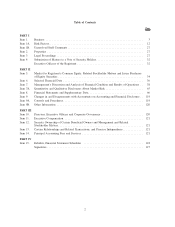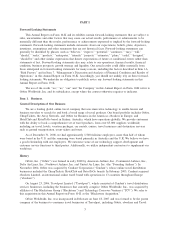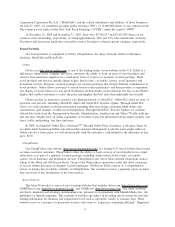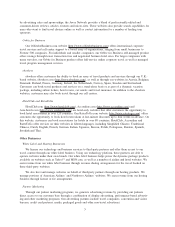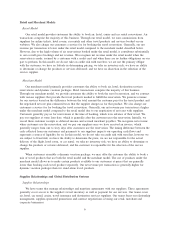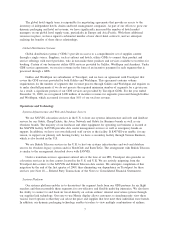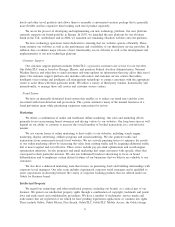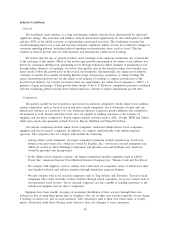Orbitz 2009 Annual Report Download - page 12
Download and view the complete annual report
Please find page 12 of the 2009 Orbitz annual report below. You can navigate through the pages in the report by either clicking on the pages listed below, or by using the keyword search tool below to find specific information within the annual report.
proxy and information statements, and other information regarding issuers, including us, that file electronically
with the SEC at http://www.sec.gov.
We also use our Investor Relations website (http://www.orbitz-ir.com) to make information available to
our investors and the public. Investors and other interested persons can sign up to receive email alerts
whenever we post new information to the website.
Item 1A. Risk Factors.
Our results of operations and financial condition could be materially adversely impacted by the economic
downturn and our level of indebtedness increases our sensitivity to this risk.
The global economy is experiencing a severe and prolonged recession as a result of the deterioration in
the capital markets and related financial crisis. Both our customers and suppliers have felt the impact of this
downturn. For example, several U.S. airlines have implemented capacity reductions and higher air fares in the
face of slowing customer demand and are under increased pressure to reduce their overall distribution costs.
As a result, our suppliers could attempt to terminate or renegotiate their agreements with us on more favorable
terms to them, which could reduce the revenue we generate from those agreements. The weakness in the
economy has also negatively impacted consumer spending patterns, including as it relates to the travel
products offered on our websites. If consumer demand for travel and the products offered on our websites
continues to decrease, our revenues may decline.
If economic conditions do not improve, or worsen, our results of operations and financial condition could
be materially adversely impacted. In addition, a substantial or prolonged material adverse impact on our results
of operations and financial condition could affect our ability to satisfy the financial covenants in our senior
secured credit agreement, which could result in our having to seek amendments or waivers from our lenders to
avoid the termination of commitments and/or the acceleration of the maturity of amounts that are outstanding
under our term loan and revolving credit facility. The cost of our obtaining an amendment or waiver could be
significant, and could substantially increase our cost of borrowing over the remaining term of our senior
secured credit agreement. Further, there can be no assurance that we would be able to obtain an amendment or
waiver. If our lenders were unwilling to enter into an amendment or provide a waiver, all amounts outstanding
under our term loan and revolving credit facility would become immediately due and payable.
Our liquidity has been, and may continue to be, negatively impacted.
The weak and volatile conditions in the global financial markets and financial sector have caused a
substantial deterioration in the capital markets which has diminished the availability of funds and increased the
cost of raising capital. In response, many lenders and institutional investors have increased interest rates,
enacted tighter lending standards and reduced, and in some cases ceased, funding borrowers. We have already
experienced the negative effects of this deterioration on our liquidity. Specifically, the bankruptcy filing by
Lehman Commercial Paper Inc., which held a $12.5 million commitment under our revolving credit facility,
effectively reduced the total availability under our revolving credit facility from $85 million to $72.5 million.
If any of our other lenders are unable or unwilling to fund their respective commitments, and we are unable to
replace these lenders, the amount available to us for borrowings and letters of credit under our revolving credit
facility would be further reduced.
In the future, we may require more liquidity than is available to us under our revolving credit facility as a
result of changes in our business model, changes to payment terms or other supplier-imposed requirements,
lower than anticipated operating cash flows or other unanticipated events, such as unfavorable outcomes in our
legal proceedings. For example, the liquidity provided by cash flows from our merchant model bookings could
be negatively impacted if our suppliers, including credit card processors and hotels, changed their payment
terms or imposed other requirements on us, such as requiring us to provide letters of credit or to establish cash
reserves, or if our merchant model bookings declined as a result of current economic conditions or other
factors.
12


